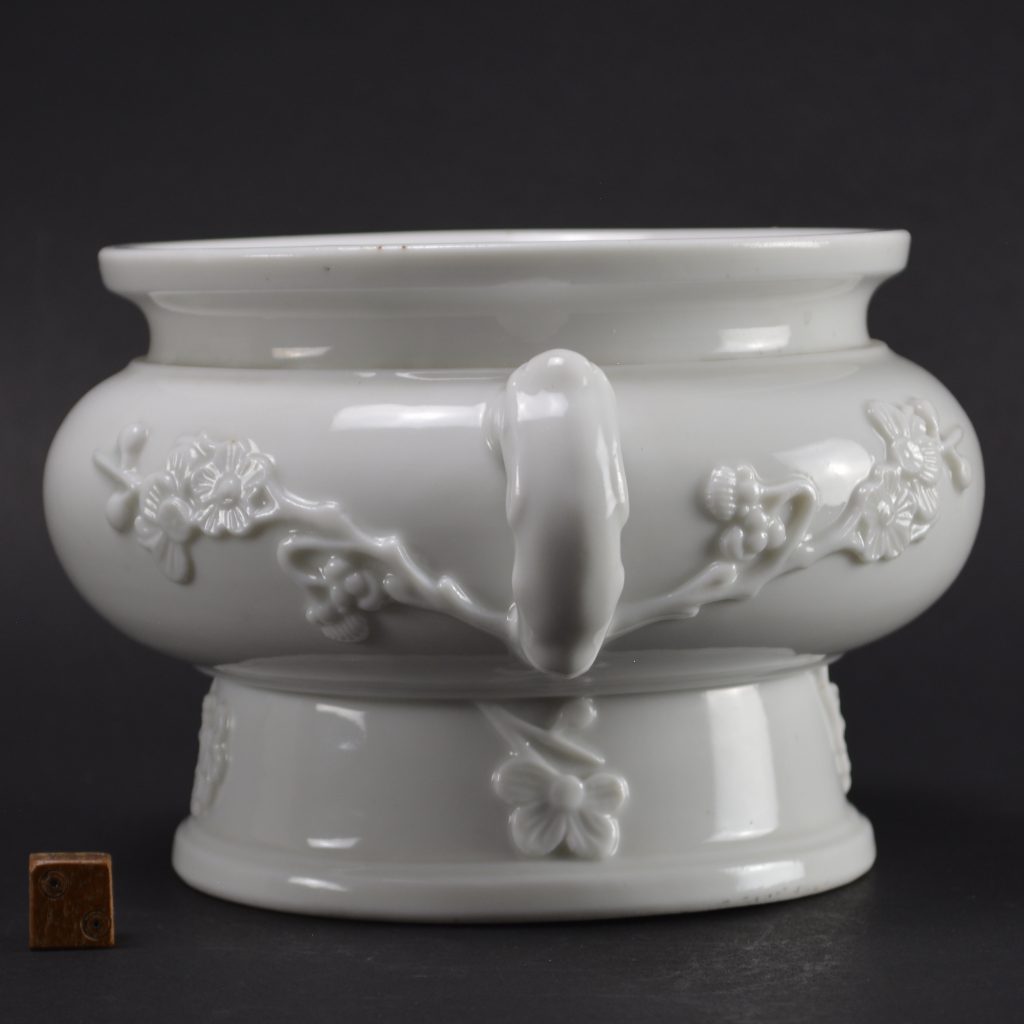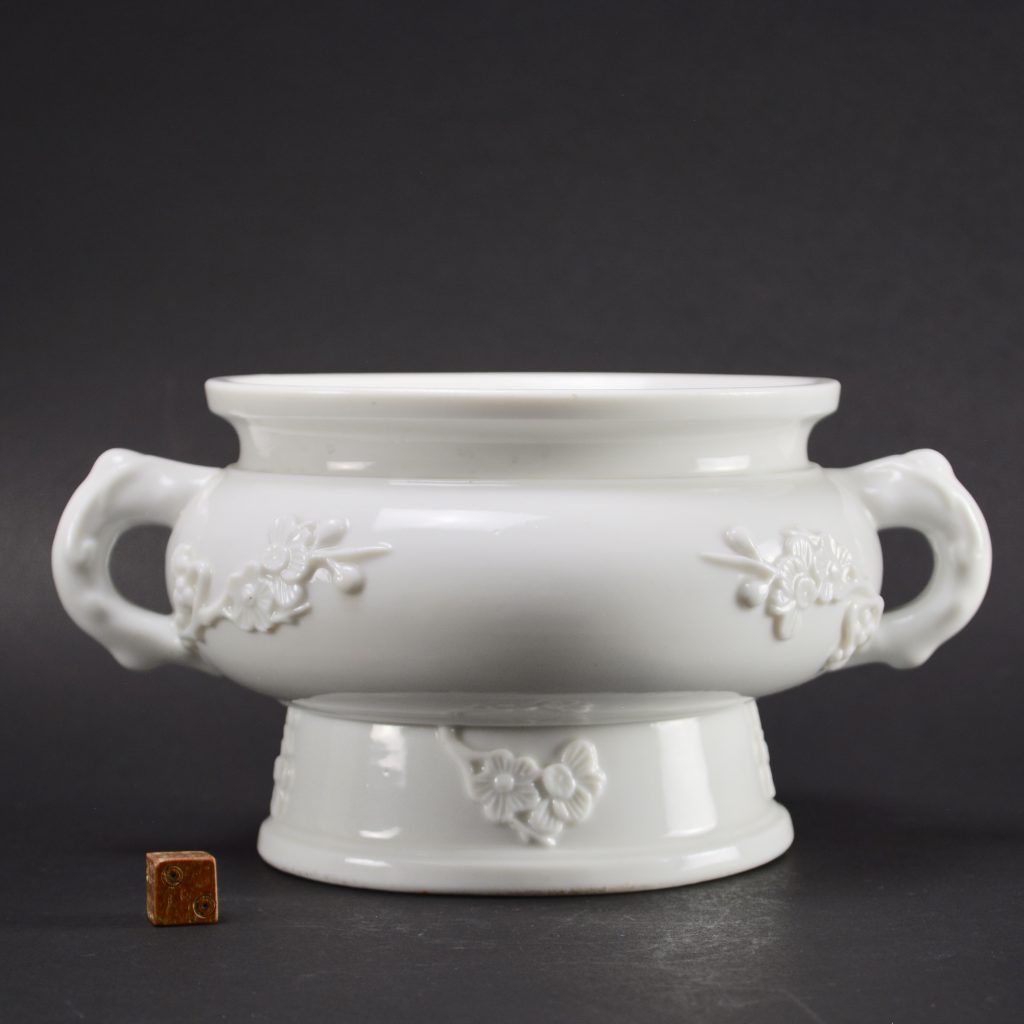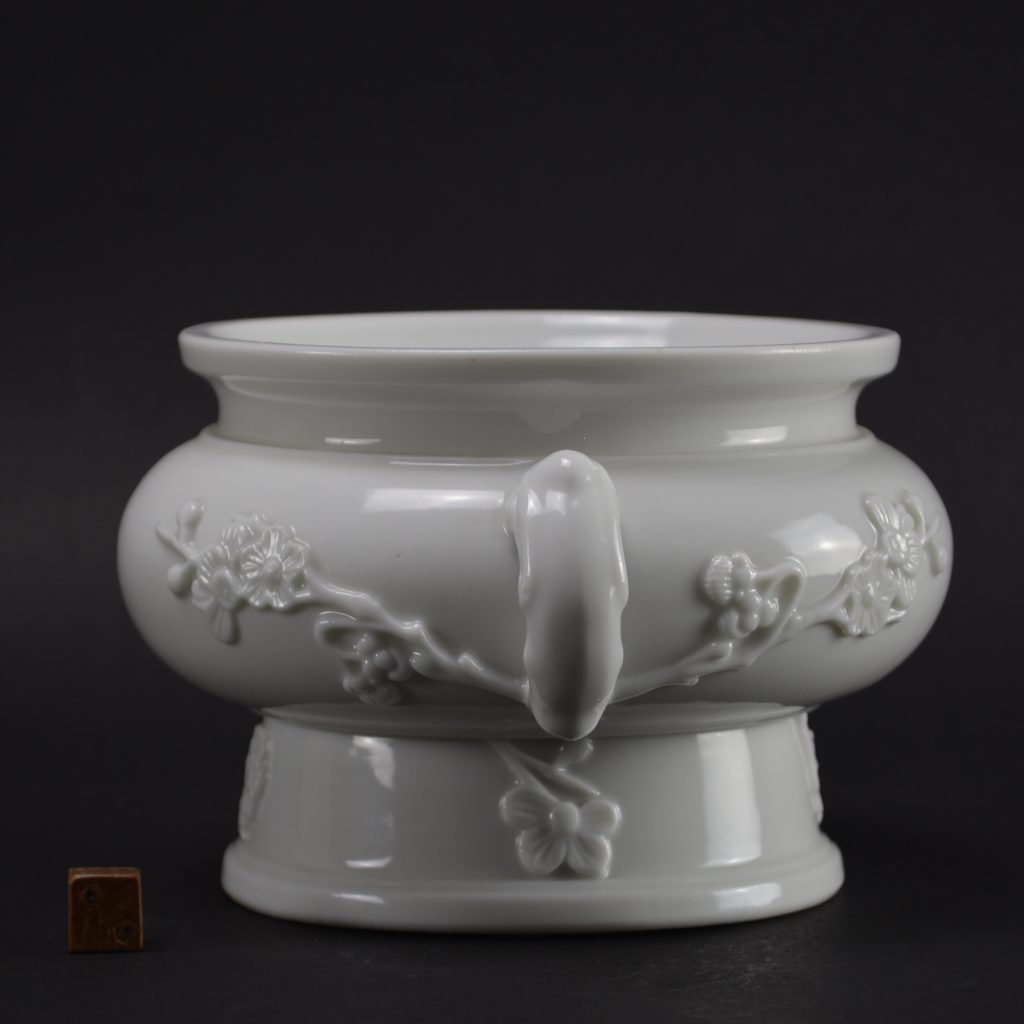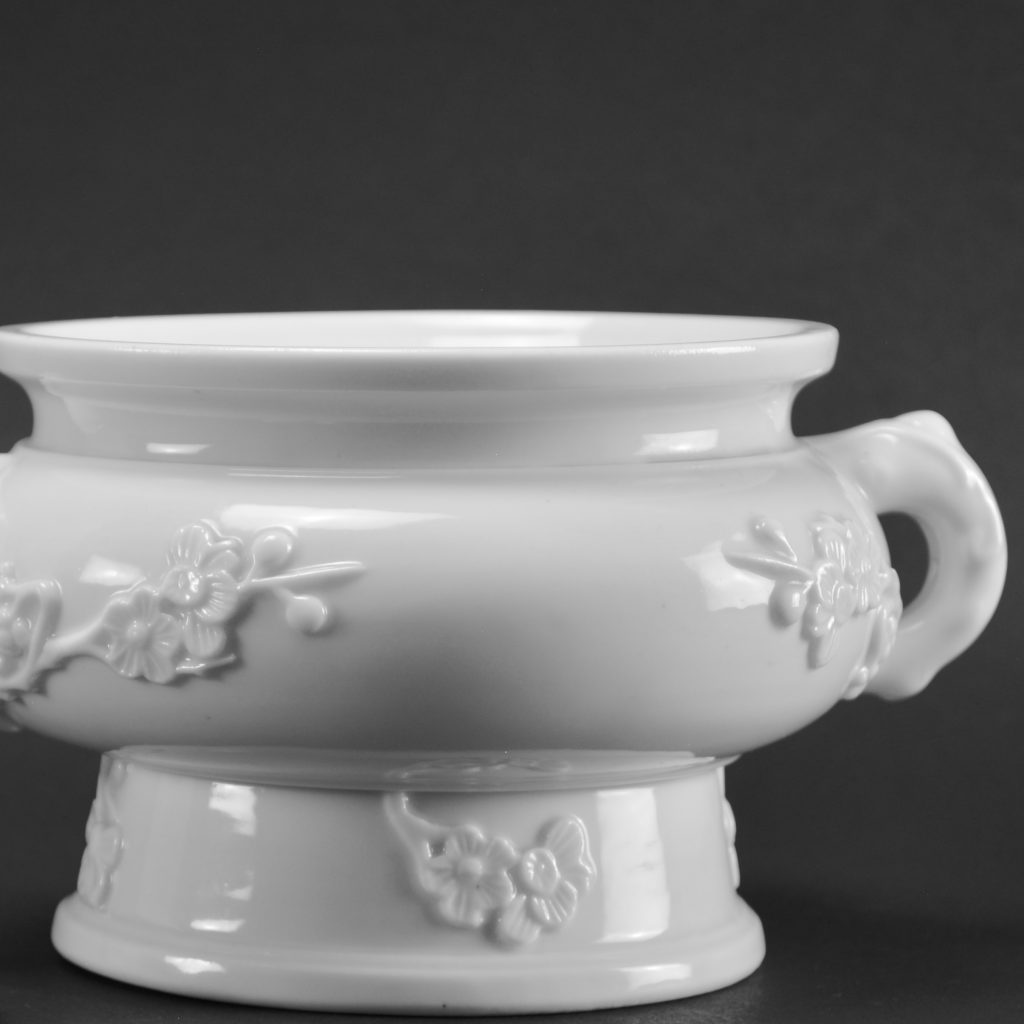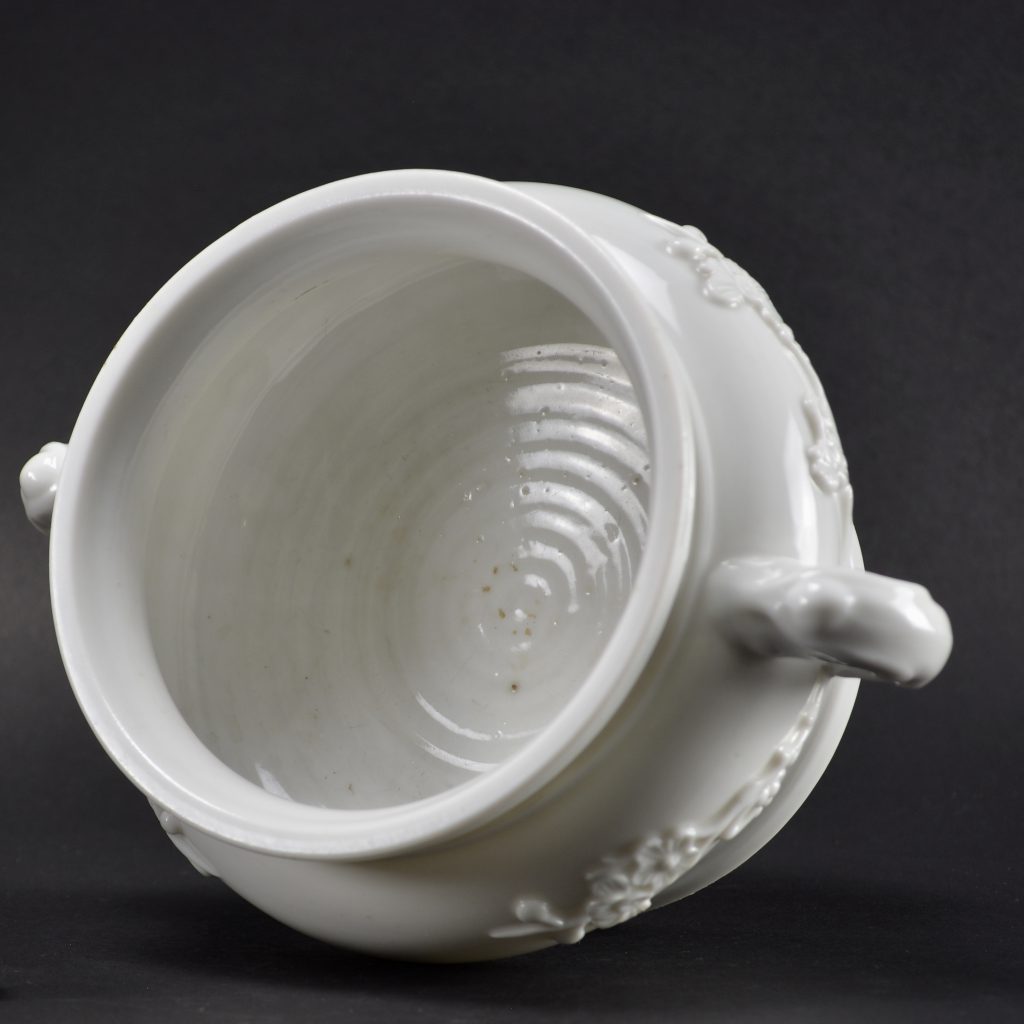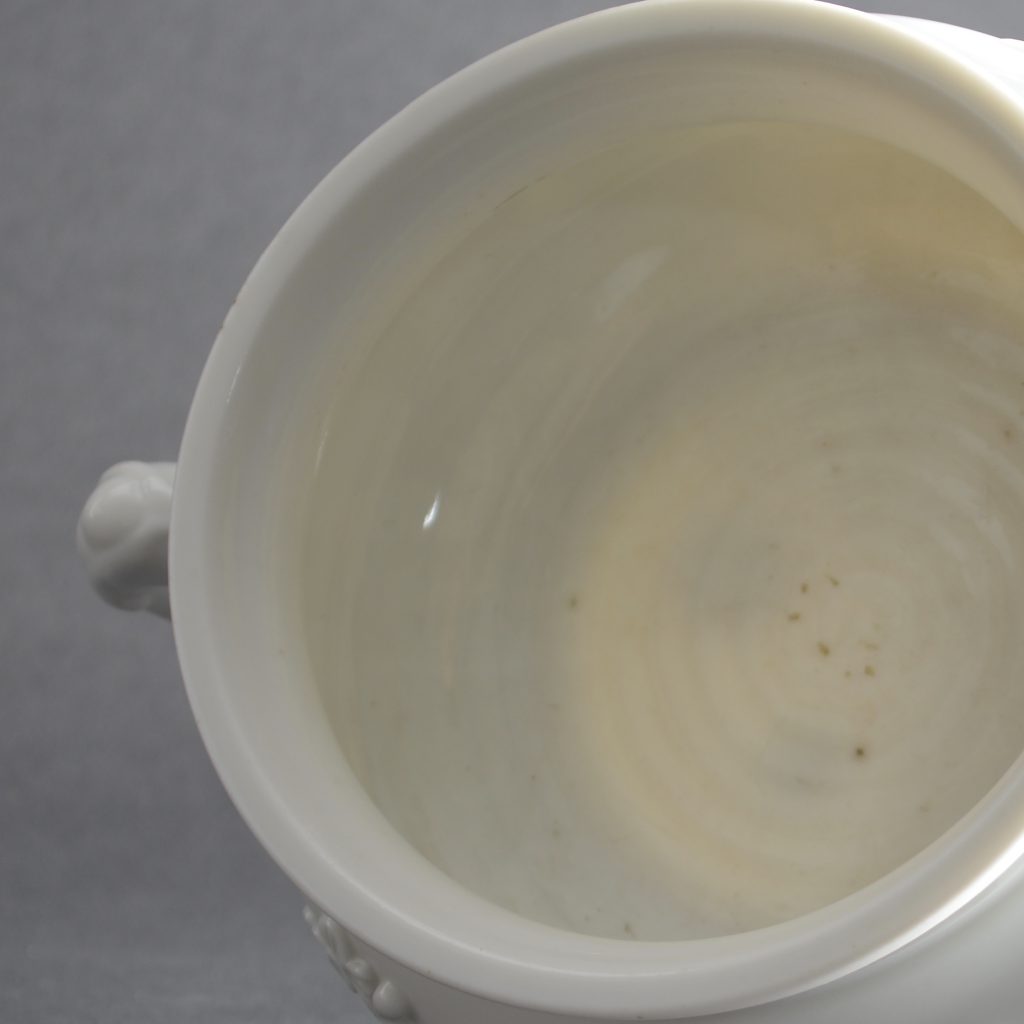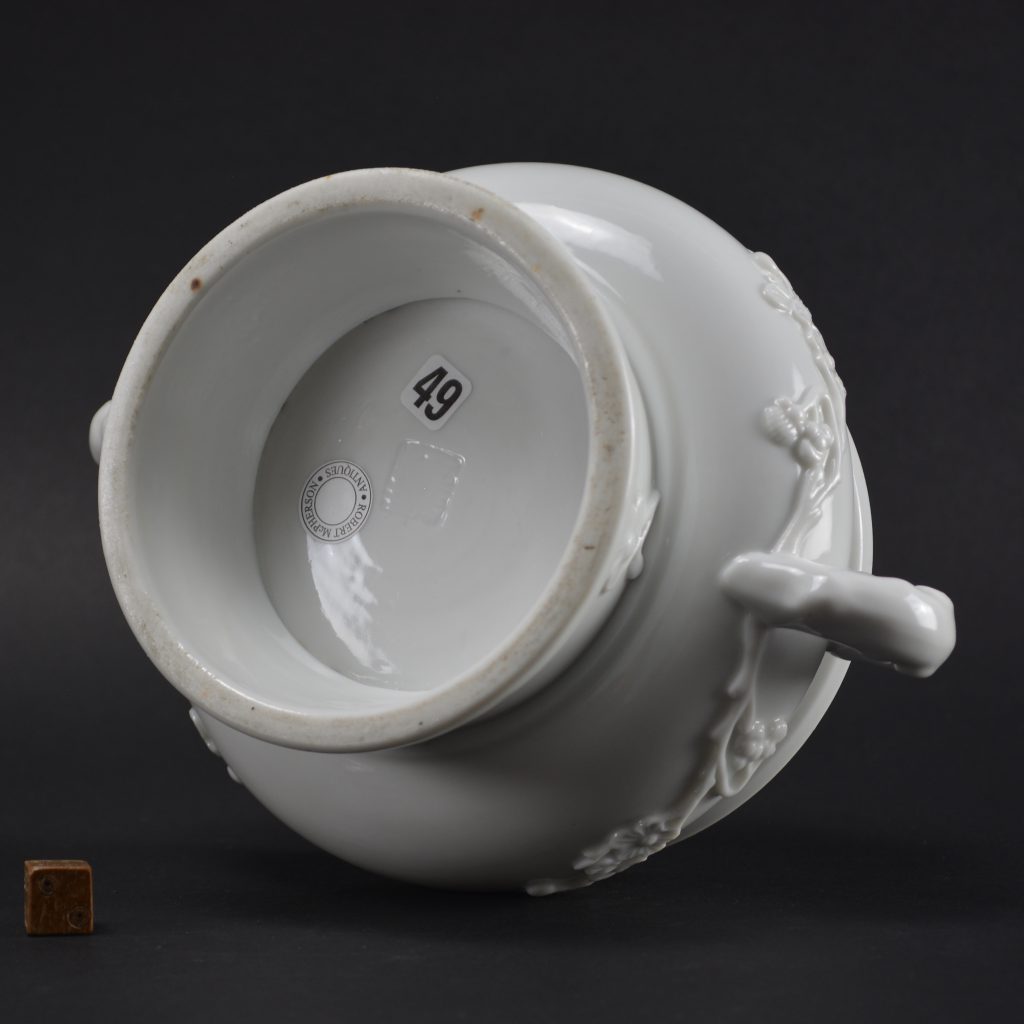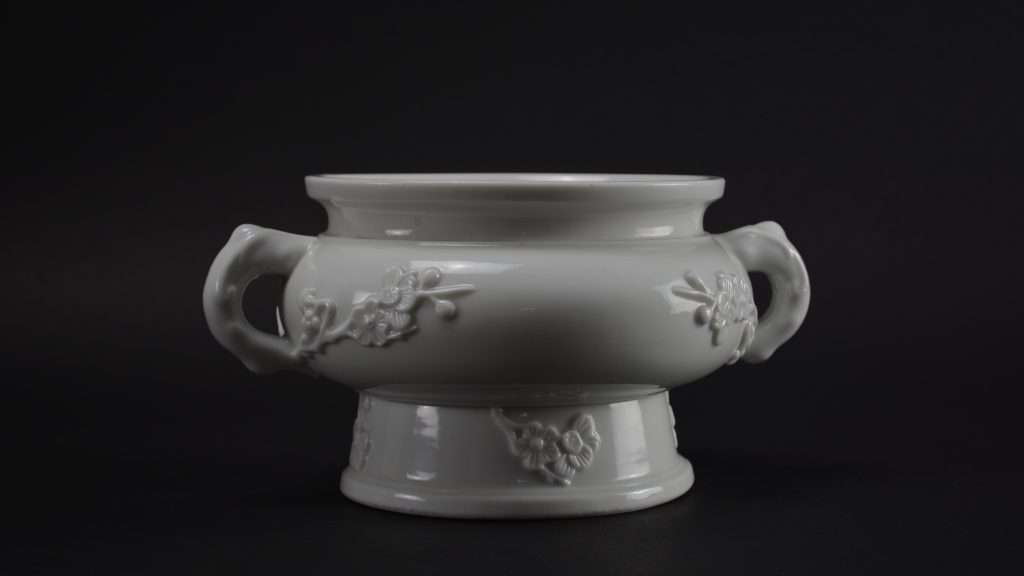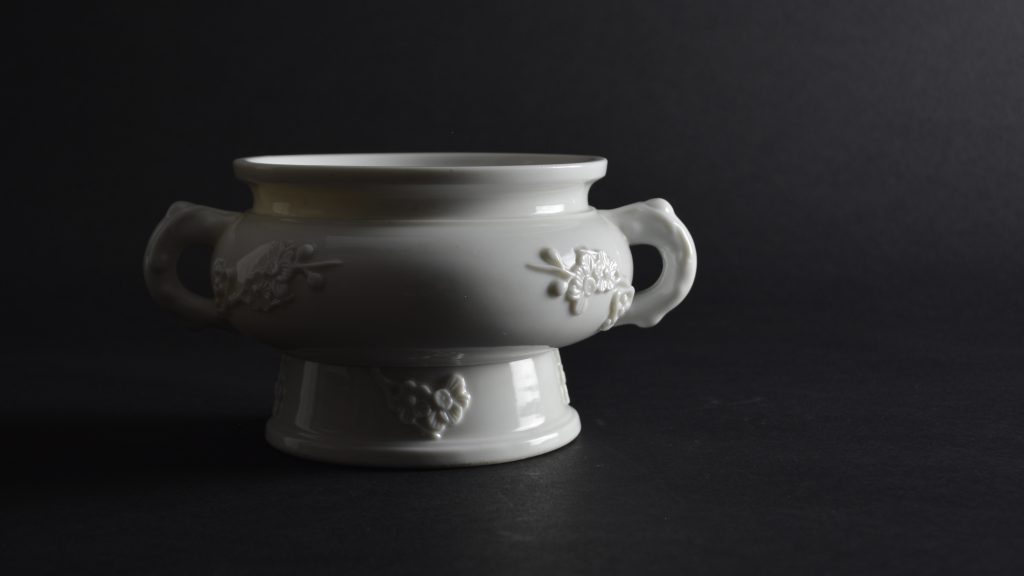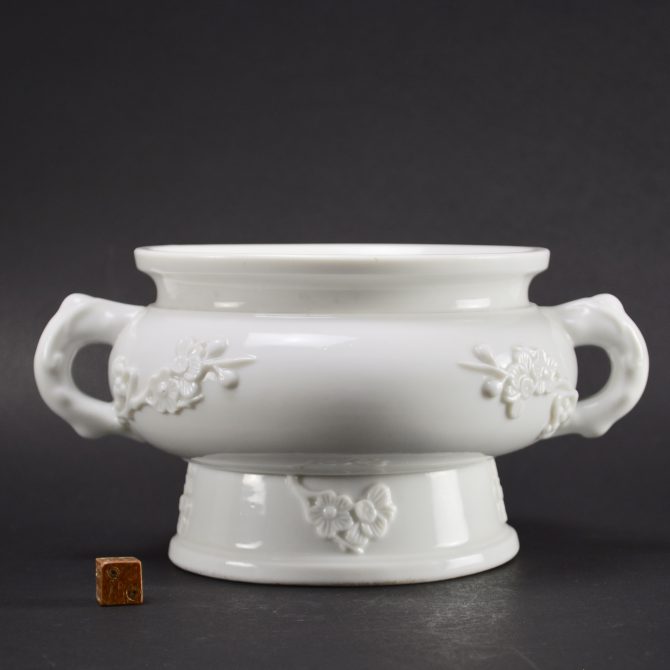
Kangxi Blanc de Chine Porcelain Censer
A Fine Large Kangxi (1662-1722) Blanc de Chine Censer, Dehua kilns, Fujian Province. Standing on a high-foot this Blanc de Chine censer is decorated with Prunus appliques and has crabstock handles. The deeply recessed base has an impressed seal-mark. The colour is white with a feint cream tinge to the glaze.
Francesco Maria, Marchese Taliani de Marchio (1887 – 1968), Grand Officer of the Italian Crown, Commander of the Order of St Maurice and Lazarus, and Commander of the Order of Pius IX (Ordine Piano), and his wife Archduchess Margaretha d’Austria Toscana, Marchesa Taliani de Marchio (1894 – 1986). According to the collection inventory list, acquired from Tung Koo Tsar Chinese Curios & Arts Co., Shanghai, 22 March 1942. See more information and photographs below the photographs of the censer.
SOLD
- Condition
- In perfect condition, it is a bit warped.
- Size
- Height 9.8 cm (3 3/4) Diameter 19.2 cm (7 1/2 inches)
- Provenance
- Francesco Maria, Marchese Taliani de Marchio (1887 - 1968), Grand Officer of the Italian Crown, Commander of the Order of St Maurice and Lazarus, and Commander of the Order of Pius IX (Ordine Piano), and his wife Archduchess Margaretha d'Austria Toscana, Marchesa Taliani de Marchio (1894 – 1986). According to the collection inventory list, acquired from Tung Koo Tsar Chinese Curios & Arts Co., Shanghai, 22 March 1942.
- Stock number
- 1
Information
Provenance
According to the collection inventory list, acquired from Tung Koo Tsar Chinese Curios & Arts Co., Shanghai, 22 March 1942.
Francesco Maria, Marchese Taliani de Marchio (1887 - 1968), Grand Officer of the Italian Crown, Commander of the Order of St Maurice and Lazarus, and Commander of the Order of Pius IX (Ordine Piano), and his wife Archduchess Margaretha d'Austria Toscana, Marchesa Taliani de Marchio (1894 – 1986).
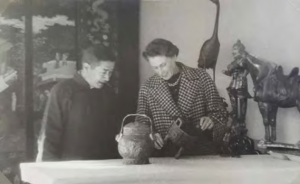
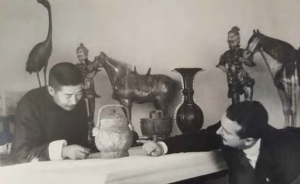
Marchese Taliani was a distinguished Italian diplomat who lived through major historical upheavals of the first half of the 20th century, events whose impact affects all to this day. His first diplomatic appointment was to Berlin in 1912; followed by Constantinople in 1913, where during the First World War he negotiated an agreement for the protection Italian citizens and interests in the (soon to demise) Ottoman Empire. From 1916 to 1919 he served in St Petersburg, and under the privilege of diplomatic immunity was in a unique position to observe and chronicle first-hand the October Revolution, its day by day development , the subsequent fall of Tsarist Russia and the establishment of the Soviet Republic; from 1919 he served in Rome as Secretary of State for the Minister of Foreign Affairs; with later assignments to London (1921 - 1923) and again to Constantinople (1924 – 1928), this time as the Republic of Turkey; from 1929 - 1930 he was in Rome as Head of Protocol of the Ministry of Foreign Affairs; in 1932 he was appointed Italian Ambassador to the Netherlands; in 1938 he was appointed Ambassador to China, where he remained until 1946; and his last diplomatic appointment was in 1951 as Ambassador to Spain until 1952.
Sent to China in 1938 as Ambassador to the National Chiang Kai-shek Government in Nanjing , he became an acute - and far from humourless, despite the hardships of everyday life - front line eye-witness of the Second Sino-Japanese War, during which the Japanese forces captured the capital and attacked Shanghai. When Mussolini recognised Wang Jingwei's Japanese puppet government, Taliani presented his credentials to him. On 8 September 1943, having refused to swear allegiance to the Italian Social Republic (Republic of Salò), he and his wife, the Archduchess Margaretha d'Austria Toscana (1894 - 1986), were arrested and interned by the Japanese in a concentration camp near Shanghai, where they remained for two years until the end of the war. After the end of hostilities, the new government of Alcide De Gasperi reconfirmed him as Ambassador to China until 1946.
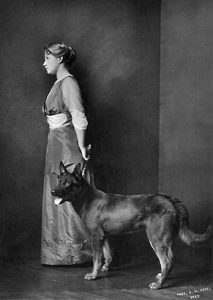
Many of the purchase invoices survive, providing an important documentation of Chinese art dealers active in Shanghai and Beijing between 1938 and 1946. The majority of the invoices are dated to between December 1938 and July 1943, with a significant gap until April 1946, explained by Marchese Taliani and his wife's internment by the Japanese. The long list of dealers demonstrates the vibrant Chinese art market in Shanghai and Beijing in the late 1930s and early 1940s; this list includes the following:
In Shanghai - K. D. Lu, Yee Chun Chang, C. K. Chou, Strehlneek's Gallery of Chinese Art, The Midoh Co., Tung Koo Tsar Chinese Curios & Arts Co., Philip Chu, Zui Wha Curios & Co., T. Y. King & Co., King Koo Chai, Tai Loong & Co., Tin Dao Shan Fang, Y. L. Hong, Chu Tsun Tsai, The China Curios Co., Hsueh Ken Chai, Zung Chang Ziang Co., The Little Pagoda, M. L. Kwauh, Hoggard – Sigler, and Foo Yuen Tsai.
In Beijing - J. Plaut, Jung Hsing Chai, Mathias Komor, Tung Ku Chai Curio and Picture Store, Yi Pao Chai Jade Store, Jung Hsing Chai, Wan E. Cheng, Yung Pao Chia Jade Store, Mario Prodan, and Tung Yi & Co.
Marchese Taliani published three books: Pietrogrado 1917, Milan, 1935; È Morto in Cina, Milan, 1949; and Dopoguerra a Shanghai, Milan, 1958.
Blanc de Chine Porcelain
The porcelain known in the West as Blanc de Chine was produced 300 miles south of the main Chinese kiln complex of Jingdezhen. The term refers to the fine grain white porcelain made at the kilns situated near Dehua in the coastal province of Fujian, these kilns also produced other types of porcelain. A rather freely painted blue and white ware, porcelain with brightly coloured `Swatow` type enamels as well as pieces with a brown iron-rich glaze.
However it is the white blanc de Chine wares that have made these kilns famous. The quality and colour achieved by the Dehua potters was partly due to the local porcelain stone, it was unusually pure and was used without kaolin being added. This, combined with a low iron content and other chemical factors within the body as well as the glaze, enabled the potters to produce superb ivory-white porcelain.
Censers
Chinese censers have a long history, they are thought to have originated in the Eastern Zhou dynasty (770 - 256 B.C.). They are normally association with paying reverence to ancestors, the smoke omitted was thought to be a way for the living to communicate with the spirit of the dead. However, from early times there have been different censers for different functions including fumigation and even pest control. They also occur in many different forms. During the Western Han dynasty Western Han (206 B.C. - A.D. 8) the Boshan Xianglu universal mountain censer was developed. These bronze censors had elaborate craggy mountain peaked covers which aloud the incense smoke to waft out of naturalistically rendered holes, like so many bronze forms they were copied by potters who made lead-glazed pottery versions. The incense cones that created this smoke were made from plants, including magnolia, grasses and lovage, however early Taoists might have preferred something stronger, adapted censers for the religious and spiritual use of cannabis. Yuan, Ming and Qing dynasty ladies at court used novelty censers to fumigate new cloths, a Yuan poem includes the lines "The incense continues burning in the golden duck censor `til midnight, as court ladies keep trying on their new garments of silk and muslin". For a Ming dynasty bird form celadon censer see sold items stock number 18026. Most Chinese censer are, however, of circular form and sit on three low feet, the interior is unglazed and left in a biscuit state. Some of the Yuan and Ming celadon censers have impressed decoration to this biscuit area. Sand was placed inside the censer and josticks or cones were used. Many family`s had an alter at home where rituals were performed and respect was paid to their ancestors, incense burners were an important object in this context, often forming part of an alter garniature with a pair of vases. Indeed we know from the inscription on the famous `David Temple` vases now at the British Museum, not only that they were made in the year 1351, but that there was originally a censer with them, unfortunately now lost, (for an illustration of these important Yuan vases see our `Links` section, where they are shown next to the link to the British Museum website where you can read more about them). Because of there ritual use, censers, like the missing David censer, were sometimes commissioned for a specific temple or other building. They person commissioning them sometimes had a dedicatory inscription added. For example the Dehua blue and white censer, stock number 19766 (see `Sold` items). This has an inscription that mentions the name of the family who presented it, as well as the temple the piece was given to, along with a date, the twelfth year of Qianlong (1736 - 1795) equivalent to 1748. It also asks for more children and riches. China`s renewed connection with its spiritual past has meant that censers are once again being lit across the land.
Plum Blossom
Chinese plum, Mei, is a species of Asian plum in the family Rosaceae. There are 300 recorded cultivars of Mei. It is one of the most popular flowers in China, plum blossom has been depicted in Chinese art and poetry for many centuries and is still very popular today. To the Chinese its blossom is both a symbol of winter, as well as a harbinger of spring. They bloom vibrantly amidst the winter snow after most other plants have shed their leaves, and before other flowers appear. They are seen as an example of resilience and perseverance in the face of adversity. The plum blossom is a member of `Three Friends of the Winter`, along with pine, and bamboo. The plum blossom is also a member of `Four Gentlemen of Flowers` in Chinese art (the others being orchid, chrysanthemum, and bamboo), symbolizing nobility. It is also one of the four seasonal flowers.
